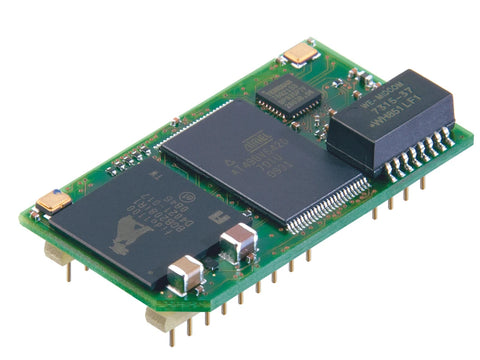Ask our Engineers Anything:
Should I implement EtherNet/IP, PROFINET, or both in my device, and how?
EtherNet/IP and PROFINET are two protocols that utilize and add value to standard ethernet technology.
Speed is often mentioned as a key benefit of PROFINET, while interoperability often goes into the EtherNet/IP column. Yet when it comes to one over the other, it's not so black and white. For product design and development, you may want to hedge your bets and support both.
The global industrial ethernet market is growing at 7.2% CAGR and expected to surpass $15 billion by 2027. Looking at market share, PROFINET is overall the leading Industrial Ethernet protocol worldwide, yet EtherNet/IP (EIP) is becoming more popular as an industrial networking standard.
Source: Global Industrial Ethernet Market, published by KBV research.
Since both PROFINET and EtherNet/IP are widely adopted, this article will present some background information and offer three primary options for including them into your product design.
About EtherNet/IP (EIP) and PROFINET
With backing by Wisconsin-based, North American giant Rockwell Automation and others, EtherNet/IP has a strong presence in the US and Canada. Rockwell Automation has been in the game for years through ongoing development of their control networks.
PROFINET is very strong in Europe, with backing by Siemens and others. As mentioned, it is strong worldwide, including substantial market share in North America. While PROFINET is based on the PROFIBUS standard, it is not simply PROFIBUS over Ethernet. PROFINET is generally faster overall than EtherNet/IP, but it can require special hardware for some applications.
Open standards with governance
Part of the appeal of EtherNet/IP and PROFINET is that both are open standards, yet both also have governing bodies in place to guide development and ensure certain requirements are met.
PROFIBUS and PROFINET International (PI)

Known as PI for short, this organization has about 1,700 member companies globally and offers PROFIBUS and PROFINET competence centers, training centers, test labs and certifications, and various working groups and technical committees.
Visit the PI website to learn more
Open DeviceNet Vendors Association (ODVA)

Known as ODVA, the members of this global association are leading industrial automation companies. The stated mission of ODVA is to advance open, interoperable industrial automation technologies. ODVA's network protocol, the Common Industrial Protocol or CIP, is core to its mission, supporting the adoption of commercial-off-the-shelf products and standard internet and ethernet technologies.
Visit the ODVA website to learn more.
Note that Grid Connect is both a PI member and ODVA member.
EtherNet/IP and PROFINET considerations
As mentioned already, EIP and PROFINET are both open source for greater interoperability and more options to use off-the-shelf components. Following are important considerations when assessing these protocols for your product development plans.
Certification requirements
An important point to remember when adding one of these protocols to a device is that the device must be certified by the appropriate body, ODVA or PI, in order to be sold on the open market as an EtherNet/IP or PROFINET capable device.
This involves testing of the device in a certified lab, which runs a standard set of conformance tests on the product. There are costs associated with this testing and manufacturers should consult with the appropriate body to understand the timing, costs, and documentation needed.
Three implementation options
Device manufacturers looking to add industrial protocols to their device have three main options for getting this done.
1. Do-It-Yourself (DIY)
You can develop or buy a PROFINET or EtherNet/IP stack and run it on the native microcontroller of the device.
The DIY approach makes sense when the projected sales volumes justify the additional development expense. If the device manufacturer has a willing customer who has time to wait for the R&D and will buy sufficient quantities, then this approach makes sense.
Adding a new protocol stack to a device’s existing software base may require making hardware changes to the device as well. For example, adding a protocol stack to the software will increase the load on resources such as RAM and Flash memory. If the load is too much, then additional RAM and/or Flash will have to be added to the microcontroller PCB. Another reason for needing to change the PCB is if an Ethernet RJ45 Connector needs to be added to connect the device to the PROFINET or EtherNet/IP network.
When you consider this plus the learning curve for understanding the protocol plus certification costs, the DIY approach is not for the faint of heart. The trade-offs are lower Bill of Material (BOM) costs vs. longer time to market and much higher R&D costs.
2. Buy-the-stack-on-board
You can buy a chip or module with the stack already developed and interface it to the microcontroller of the device.
A buy-the-stack-on-board option avoids the long lead time and R&D expense of the DIY approach. It can be accomplished with a single protocol embedded module. Such a module typically interfaces with the device’s native microcontroller via a serial or SPI connection. This does not avoid the hardware R&D expense as the device’s PCB needs to be redesigned to accommodate the module, but this is typically a relatively simple and straightforward modification.
The interface through the serial port is also relatively simple and is typically done using the serial Modbus RTU protocol. Many devices have support for this already developed within the device microcontroller, so software development is often minimal. This makes time to market much faster than the DIY approach with much reduced R&D expense.
In addition, these modules often have been pre-certified (depending on the protocols certification rules), which makes certification of the OEM device faster and less costly. An example of such a module is Grid Connect’s EtherNet/IP XPort. This module is a cost-effective and quick time-to-market approach to adding EtherNet/IP to a device.
Note that we are working on a next generation EtherNet/IP module that adds wireless capability.
3. Future-proof-module
Finally, you can buy a module that has multiple variants supporting a variety of Industrial fieldbus protocols where all versions of the module have the same footprint.
Building on the module approach, this is the multiprotocol module with a uniform footprint, allowing for multiple fieldbus / industrial networking protocols to be added to a device without redesigning the PCB. Simply plug in a module with the desired protocol and the device is multilingual. Additional accommodations may be needed if the chosen field buses have different physical interfaces, such as RJ45 for Industrial Ethernet protocols or a DB9 connector for a fieldbus such as PROFIBUS. With these module families, the device microcontroller interfaces through serial or SPI interfaces to the module just like with the previous approach.
Typically, however, no other modifications to the device’s software are needed when switching from one protocol module to another. So instead of designing to add one or two protocols, such as EtherNet/IP and PROFINET, suddenly all of the major protocols—like PROFIBUS, DeviceNet, and Modbus TCP, to name a few— are available with little to no additional cost, other than certification.
This approach makes sense when the volume is low, as the modules are typically more expensive than the other two approaches, or when maximum flexibility is needed.
Available EIP and PROFINET modules
Grid Connect offers the Unigate IC module family from Deutschmann Automation, a German company that's been making network components for industrial data communication for over thirty years. As pre-certified communication interfaces, Unigate IC modules can be directly integrated into the electronics of the terminal device without changes in the firmware, which is important when the firmware has been certified. UNIGATE IC is an excellent alternative to developing your own interfaces.
 |
Deutschmann Automation EtherNet/IP module |
 |
Deutschmann Automation PROFINET module |
 |
Deutschmann Automation PROFIBUS module |
I hope we have answered some of your own questions about these popular industrial networking protocols. If not, please don't hesitate to contact us to discuss your questions or concerns.






